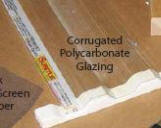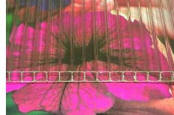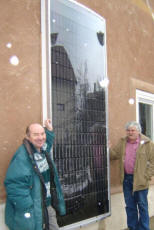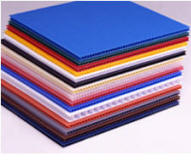Here is a table of glazing candidates
and the pros and cons as I see them.
| Collector
Glazing Materials |
| Glass |
Glass is a good glazing material for solar collectors.
High transmission (low iron) tempered glass is used on the majority of
commercial solar collectors.
Pros: long life, good transmittance, high temperature
capability, low transmittance in the long IR reduces heat loss, strong.
Cons: heavy, breakable, high cost.
Tempered glass with a low iron content is preferred. Non-tempered
glass in collectors can crack from the heat, and glass with a high iron
content transmits less light.
Many glass shops will offer blemished or pull-outs or miss-cuts at very low
prices, but will not likely stock the highest transmittance glass. |
| Polycarbonate -- Corrugated
www.palramamericas.com/Suntuf
www.palramamericas.com/Solar
Full Data Sheet ... (pdf)
Installation Guide... (pdf)
Examples:
My Solar Shop Collector...
|

This is a thin sheet of polycarbonate shaped into a corrugated pattern.
It is commonly used for greenhouses, porch roofs, ... It makes a
good glazing for solar collectors.
Pros: good transmittance, high impact resistance, good
temperature capability (270F), light weight, low cost, good life, easy
to cut, low transmittance in the long IR reduces heat loss, available at
many home centers.
Cons: Have to seal corrugation ends, must be well supported,
only 2 ft wide sheets commonly available, life and temperature
capability not as good as glass (but good). The corrugations also add some surface area compared to flat glazing, and this increases heat loss a bit.
"Wiggle" strips are sold to seal the corrugations (see picture).
Polycarbonate (GE trade name LEXAN) is very tough -- its the football
helmet stuff.
For use in collectors, it MUST have a coating or additives to resist UV.
It will not hold up to long time exposure to hot water vapor.
Nick reports that a 4 ft wide version called Dynaglas is available from
Stuppy or
Griffin greenhouse supply. |
| Polycarbonate -- Multiwall
Examples:
My Solar Shed Collector...
Alain's Collector...
Specs...
(pdf) |

This is an extruded polycarbonate glazing material that consists of multiple
panes connected by ribs. Commonly there are two panes, but there can
be up to 5 panes. It is commonly used for greenhouse and
sunspace glazing.
Pros: good transmittance (but lower than single wall), high
impact resistance, good temperature capability (270F), light weight, low
cost, good life, very nice to work with, low transmittance in the long
IR reduces heat loss, available in wide variety of widths, thicknesses,
and nearly any length, available in many cities and from greenhouse
suppliers, less heat loss due to the insulating effect of multiple
layers.
Cons: life and temperature capability not as good
as glass (but good), more expensive than single wall, but still
reasonable.
For use in collectors, it MUST have a coating or additives to resist UV.
It will not hold up to long time exposure to hot water vapor. |
| Polycarbonate -- Rigid sheet
Examples:
Wayne's Collector...
The beer can collector...
http://www.cansolair.com/
|

This would include flat rigid sheets of polycarbonate in the 1/8 to 1/4 inch
range.
This is a good glazing material. It is used on some commercial
collectors.
Pros: good transmittance, high impact resistance, good
temperature capability (270F), light weight, good life, easy to
cut, good variety of sheet sizes and thicknesses available, low
transmittance in the long IR reduces heat loss(?),
many glass shops stock it or can get it.
Cons: life and temperature capability not as good
as glass (but good), high cost.
These sheets are not as stiff as glass, and some collectors use a
gentle outward curve in the glazing to increase stiffness and rigidity.
For use in collectors, it MUST have a coating or additives to resist UV.
It will not hold up to long time exposure to hot water vapor |
| Polycarbonate -- Rigid film
Data Sheet ... (pdf) |
A rigid polycarbonate thin sheet material that is in the 0.007 to
0.03 inch thick range. It has the advantages over corrugated
polycarbonate that it comes in 4 ft widths, and does not require sealing the
corrugation ends.
I've have zero experience with this material, but it was suggest by solar
guru Nick Pine as a good choice, and it looks promising.
From Nick:
"I've bought small pieces (e.g. 4'x8') of 0.010"-0.020" thick
material from graphics suppliers, but it seems to me that the thinnest
0.007" stuff would make the best solar glazing, since it's the cheapest,
about $1/ft2 in a 4'x100' 20-pound roll. IIRC, the min order is $300,
with delivery in 2 weeks."
Pros: good transmittance, high impact resistance, good
temperature capability (270F), light weight, good life, easy to
cut, available in 4 ft wide rolls, low cost, low transmittance in the
long IR reduces heat loss(?).
Cons: life and temperature capability not as good
as glass (but good), must be special ordered from GE plastics
in rolls (although small quantities may be available
from graphics or sign businesses).
Order directly from GE Structured Products -- contact information is in
the
Data Sheet. Its not clear to me exactly how much support this material will require.
If the glazing frame applies tension to the film, it may need little
support.
For use in collectors, it MUST have a coating or additives to resist UV --
be sure to choose the type of film rated for outdoor use.
It will not hold up to long time exposure to hot water vapor |
| Rigid Acrylic Sheet Rigid PVC
sheet (flat or corrugated)
Polyethylene film (greenhouse film)
Some good uses for these glazings:
Passive gain collector...
Sunspaces and Greenhouses ...
Acrylic Data Sheet...
|
These materials can be good choices when the glazing is not exposed to high
temperatures (e.g. sunspace glazing), but they will not stand up to the
temperatures seen in solar collectors -- trust me on this -- they melt
:) |
| Sun-Lite Fiberglass Glazing
http://www.solar-components.com/SUN.HTM
|
 This
is a fiberglass reinforced plastic glazing made for solar glazing
applications by KalWall. I don't have any experience with this material. This
is a fiberglass reinforced plastic glazing made for solar glazing
applications by KalWall. I don't have any experience with this material.About $2.50 per sqft -- shipped in rolls.
SunLite Specs...
(Thanks to Paul for finding the spec sheet)
|
| Coroplast -- Horticultural grade
http://www.coroplast.com
|
 This
is the corrugated plastic the material that is commonly used for sign
boards. This material is made in a Horticultural grade which has some
UV inhibitor, and comes in "natural", which is the color of the
polypropylene resin used to make it. This material has been used as a
glazing for greenhouses. The greenhouse grade is translucent, and has
73.5% transmittance. It is guaranteed for 3 years. This
is the corrugated plastic the material that is commonly used for sign
boards. This material is made in a Horticultural grade which has some
UV inhibitor, and comes in "natural", which is the color of the
polypropylene resin used to make it. This material has been used as a
glazing for greenhouses. The greenhouse grade is translucent, and has
73.5% transmittance. It is guaranteed for 3 years.The upper
temperature limit with no loading and good support is 180F, and the material
melts at 324F.
(now if we could only convince politicians running for office to use this
version for their signs, we would have a limitless supply of free glazing
every 4 years)
(most of the above is from the Coroplast in response to an
email questions) |
| Vinyl
www.warps.com/category.asp?section=windows
|
Vinyl does not have a high enough temperature capability for use in most
solar collector applications. It can be good for things like enclosing a
porch to make a sunspace.
Richard reports that that Flex-O-Glass has done well in in a vertical air
heating collector that is protected from summer sun by an overhang.
Must be UV treated and formulated for your coldest winter temperatures. |




 This
is a fiberglass reinforced plastic glazing made for solar glazing
applications by KalWall. I don't have any experience with this material.
This
is a fiberglass reinforced plastic glazing made for solar glazing
applications by KalWall. I don't have any experience with this material. This
is the corrugated plastic the material that is commonly used for sign
boards. This material is made in a Horticultural grade which has some
UV inhibitor, and comes in "natural", which is the color of the
polypropylene resin used to make it. This material has been used as a
glazing for greenhouses. The greenhouse grade is translucent, and has
73.5% transmittance. It is guaranteed for 3 years.
This
is the corrugated plastic the material that is commonly used for sign
boards. This material is made in a Horticultural grade which has some
UV inhibitor, and comes in "natural", which is the color of the
polypropylene resin used to make it. This material has been used as a
glazing for greenhouses. The greenhouse grade is translucent, and has
73.5% transmittance. It is guaranteed for 3 years.